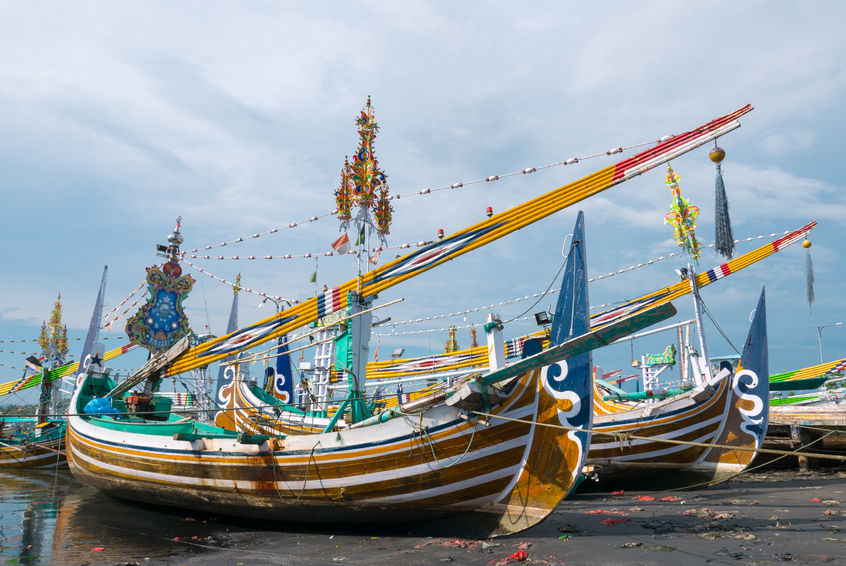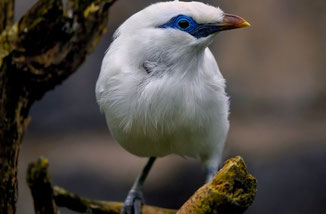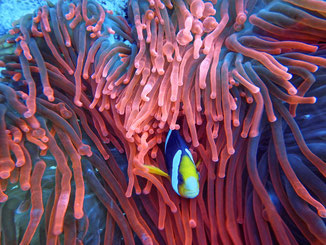jembrana
Jembrana Regency is one of the nine regencies (administrative regions) located on the island of Bali.
Location: Jembrana is situated on the western coast of Bali, facing the Indian Ocean. It is bordered by the regencies of Tabanan to the east and Buleleng to the northeast.
Capital: The capital of Jembrana Regency is Negara, which is also the largest city in the region.
Economy: Traditionally, Jembrana's economy was primarily agrarian, with rice cultivation being one of the main activities. However, like many other areas in Bali, tourism has also become an essential part of the local economy.
Agriculture: Apart from rice, Jembrana is known for growing various crops, including corn, peanuts, and cloves.
Unique Bull Races: One of the distinctive cultural events of Jembrana is the "Makepung" or bull races. This traditional event involves racing water buffaloes pulling wooden carts. Makepung is a significant attraction for both locals and tourists, showcasing the rich heritage and cultural identity of the region.
Beaches: Jembrana has some beautiful black sand beaches along its western coast, making it an ideal destination for beach enthusiasts seeking a more serene and less crowded experience compared to some other parts of Bali.
Conservation: Jembrana Regency is home to the West Bali National Park, a protected area known for its diverse wildlife and natural beauty.
Jembrana History:
The history of Jembrana Regency in Bali dates back to ancient times and has seen various influences and developments over the centuries.
Prehistoric Era: Bali, including the region that is now Jembrana, was inhabited by humans as early as the prehistoric period. Archaeological findings suggest that Bali's earliest inhabitants lived on the island as far back as the Stone Age, around 3000 BCE.
Ancient Kingdoms: Throughout Bali's history, various Hindu and Buddhist kingdoms have risen and fallen on the island. These kingdoms played a crucial role in shaping Bali's culture and society. The historical records about specific events in the Jembrana region during this period might be limited, but it was likely under the influence of the dominant kingdoms of central and southern Bali.
Majapahit Empire: In the 13th to 15th centuries, the powerful Majapahit Empire, based in Java, extended its influence over Bali. During this time, the influence of Hinduism increased significantly in Bali, leaving a lasting impact on the island's culture and religious practices.
Colonial Era: In the 19th century, the Dutch East India Company (VOC) began its control over Indonesia, including Bali. The Dutch colonial administration had a substantial impact on the island, including the Jembrana region. However, the Balinese kingdoms remained relatively autonomous under Dutch rule.
Indonesian Independence: After the Japanese occupation during World War II, Indonesia declared its independence in 1945. The Dutch attempted to retake control, leading to a struggle for independence known as the Indonesian National Revolution. In 1949, the Dutch officially recognized Indonesia's sovereignty, and the country became the Republic of Indonesia.
Formation of Jembrana Regency: The administrative divisions of Bali have evolved over time. Jembrana Regency was established as a separate administrative region during the reorganization of Indonesia's regencies and provinces. The exact date of its formation as a regency might vary depending on the historical source, but it was likely in the mid-20th century.
Modern Developments: In more recent times, Jembrana Regency has seen developments in infrastructure, agriculture, and tourism. The region's economy has diversified, with tourism playing an increasing role alongside traditional agricultural practices.
Makepung or bull races
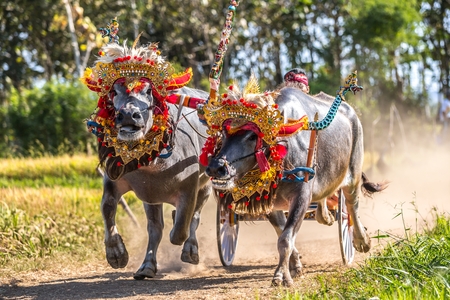
Makepung bull races are a traditional form of buffalo racing that takes place in the regency of Jembrana. This region is known for its agricultural practices and livestock culture. The word "Makepung" comes from the Balinese language, where "ma" means "to chase" and "kepung" means "to trap," symbolizing the essence of the event.
The event involves pairs of water buffalos pulling wooden plows or small carts called "cikar" that are driven by jockeys. These races are held on a muddy race track in rice paddies, adding to the excitement and challenge of the event. It's a lively and colorful spectacle, and the bulls are often adorned with traditional ornaments and brightly colored garments.
The history of Makepung can be traced back to the early 20th century when it was originally a form of pre-harvest celebration among farmers in Jembrana. Over time, it evolved into a more organized and competitive event, with various communities participating and even betting on the races. The races are often accompanied by traditional music, dance performances, and local festivities.
The exact dates of Makepung races may vary from year to year, and the event is often part of the local calendar of festivals and ceremonies. Typically, the racing season begins around July and continues until November. However, it is essential to check with up-to-date sources to get accurate and specific information about the exact dates of the Makepung bull races.
Jegog
Jegog is a traditional bamboo gamelan ensemble that originates from the island of Bali, Indonesia. It is a unique and fascinating musical tradition that showcases the creativity and ingenuity of Balinese culture. Jegog is typical of Jembrana and is seldom heard outside the regency.
Bamboo Gamelan: Gamelan refers to traditional musical ensembles in Indonesia, typically consisting of percussive instruments such as metallophones, xylophones, drums, gongs, and bamboo instruments. Jegog is distinguished by its use of bamboo instruments, making it one of the largest and most striking gamelan ensembles.
Instrumentation: The jegog ensemble primarily features large bamboo marimbas, which are known as jegogan or jegog instruments. These are essentially bamboo tubes of varying sizes and lengths, carefully cut and tuned to produce different pitches. Some ensembles might also include other traditional gamelan instruments like gongs and drums.
Size and Sound: What makes jegog truly exceptional is the size of its bamboo tubes. Some of the tubes can be as long as four to five meters (about 13 to 16 feet) and have a diameter of around 15 to 20 centimeters (6 to 8 inches). Due to their impressive size, jegog instruments can produce deep and resonant sounds that are both powerful and melodious.
Performance and Repertoire: Jegog performances are vibrant and captivating experiences. The ensemble is usually played in a seated position, with each musician handling a few bamboo tubes and striking them with mallets to create the desired tones. The repertoire of jegog music includes traditional Balinese compositions, often based on ancient melodies and rhythmic patterns.
Cultural Significance: Jegog music is deeply rooted in Balinese culture and is associated with various rituals, ceremonies, and cultural events. It is often performed during temple festivals, weddings, and other important occasions, where it adds a lively and festive atmosphere to the celebrations.
Tourism and Preservation: In addition to its cultural significance, jegog has gained popularity among tourists visiting Bali. The unique sound and visual spectacle of the ensemble make it a favorite attraction for those interested in traditional music and cultural performances. The popularity of jegog performances has contributed to its preservation and continued practice within Bali and beyond.
West Bali National Park
West Bali National Park is a protected area located on the western tip of the island of Bali. It was established as a national park in 1941 and covers an area of approximately 190 square kilometers. The park encompasses both terrestrial and marine ecosystems, making it a unique and diverse conservation area.
History:
West Bali National Park has a rich history that dates back to ancient times. It is believed that the area was once a part of the ancient Balinese kingdom and was used as a hunting ground for the royal family. In the early 20th century, the Dutch colonial administration designated the region as a game reserve to protect the local flora and fauna.
Nature and Wildlife:
The national park boasts a wide variety of ecosystems, including savannahs, rainforests, mangroves, and coral reefs. This diverse environment provides habitat for a range of wildlife species.
Some of the notable animals that can be found in the West Bali National Park include:
Bali Starling (Leucopsar rothschildi): Also known as the Bali Mynah, this critically endangered bird is endemic to Bali and is one of the most iconic species protected within the park.
Banteng (Bos javanicus): The wild banteng, a species of wild cattle, can also be found in the park. It is a threatened species and has been listed as endangered.
Rusa Deer (Rusa timorensis): This species of deer is native to Southeast Asia and is also present within the park's boundaries.
Wild Boar (Sus scrofa): A common sight in many forests, wild boars are found in West Bali National Park as well.
Macaques: Several species of macaques, such as the long-tailed macaque, inhabit the park.
Various bird species: Apart from the Bali Starling, the park is home to a diverse array of birdlife, including various species of parrots, eagles, and water birds.
Marine Life:
The park also encompasses coral reefs and coastal areas, supporting a wide range of marine life, including colorful corals, various fish species, sea turtles, and occasionally, dolphins and whales.
Conservation Efforts:
Due to its critical role in protecting endangered species and preserving Bali's unique biodiversity, the West Bali National Park is closely monitored and managed by the Indonesian government and various conservation organizations. Efforts are made to combat poaching, illegal fishing, and habitat destruction to ensure the survival of the park's precious flora and fauna.
West Bali national park hiking trails
The West Bali National Park offers several hiking trails that allow visitors to explore and appreciate its natural beauty and diverse ecosystems. Please note that trail conditions and regulations may change over time, so it's essential to check with the park authorities or local guides for the latest information before embarking on any hike. Here are some of the popular hiking trails in the West Bali National Park:
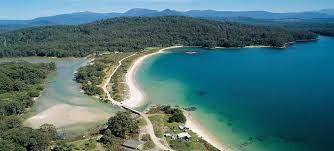
Prapat Agung Peninsula Trail: This trail takes you through the scenic landscape of the Prapat Agung Peninsula, offering breathtaking views of the surrounding coastline and the Indian Ocean. Along the way, you may encounter various wildlife species, including monkeys, deer, and a variety of birds. The trail also passes through mangrove forests, adding to the overall diversity of the hike.
Teluk Terima Trail: This trail leads to the beautiful Terima Bay, where you can enjoy pristine beaches and the crystal-clear waters of the bay. The hike typically takes you through dense forest areas and offers opportunities to spot native wildlife. You might also find spots for birdwatching along the trail.
Manjangan Island Trail: Manjangan Island is located within the boundaries of the West Bali National Park and is known for its excellent snorkeling and diving opportunities. While it's more common to explore the island's marine life, there are also hiking opportunities to explore the island's interior and enjoy the views from elevated points.

Segara Rupek Trail: This trail leads to Segara Rupek, a coastal area within the national park. The hike takes you through lush vegetation and offers glimpses of the park's diverse flora and fauna. The area is also known for its mangrove forests, adding to the appeal of the trail.
Tegal Bunder Trail: This trail takes you to Tegal Bunder, a scenic spot with views of the sea and the park's landscape. It's a relatively easy hike and offers opportunities for birdwatching and wildlife spotting.
When hiking in West Bali National Park, it's crucial to follow park regulations, stay on designated trails, and be respectful of the environment and wildlife. As with any outdoor activity, make sure to bring plenty of water, wear appropriate clothing and footwear, and be prepared for the weather conditions.
Medewi Beach
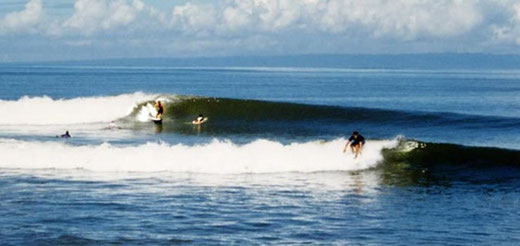
Medewi is a popular surfing destination located in the regency of Jembrana, on the western coast of Bali. It is known for its long, peeling left-hand waves, making it a favorite spot for surfers of all levels.
Surfing: Medewi is renowned for its consistent and mellow waves, making it an excellent location for both beginner and intermediate surfers. The waves are not too powerful, and the long rides give surfers plenty of time to enjoy the experience. The coastline is rocky, and the waves break over a reef, so it's essential for surfers to exercise caution and be mindful of the tides and currents.
Quiet and Relaxed Atmosphere: Unlike some of the more bustling tourist destinations in Bali, Medewi maintains a quieter and more laid-back ambiance. It is an excellent escape for those seeking a more tranquil and authentic Balinese experience.
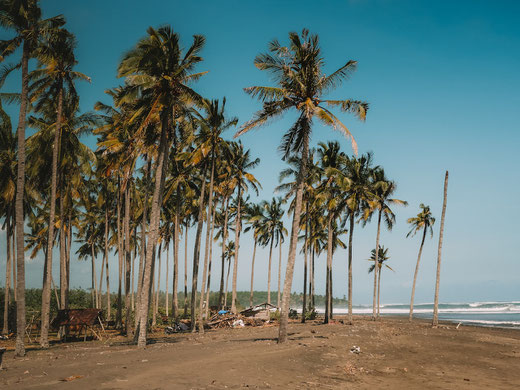
Accommodations: Medewi offers various accommodations, including hotels, guesthouses, and surf camps that cater to the surfing community. You can find options ranging from budget-friendly to more luxurious, but overall, the area is not as developed as some other parts of Bali.
Scenic Surroundings: The Medewi area is known for its beautiful coastal landscapes and rice terraces, providing travelers with opportunities for leisurely walks and exploration.
Location: Medewi is situated approximately 75 kilometers (about 47 miles) northwest of Denpasar, the capital city of Bali. The drive from Denpasar to Medewi takes around 2 to 3 hours, depending on traffic conditions.
Local Culture: Being in the regency of Jembrana, which is less influenced by tourism compared to other parts of Bali, Medewi offers visitors a chance to experience more of the traditional Balinese culture and customs.
Gilimanuk
Gilimanuk is a small port town located on the western tip of Bali. It serves as an important gateway between Bali and the neighboring island of Java.
Location: Gilimanuk is situated on the Bali Strait, which separates Bali from Java. It is part of the Jembrana Regency in Bali.
Transportation Hub: One of the main reasons Gilimanuk is significant is its role as a major transportation hub. Ferries operate between Gilimanuk and the port of Ketapang in Banyuwangi, East Java, providing a vital link between the two islands. The ferry crossing is an essential transportation route for both passengers and goods.
Gateway to Java: For travelers coming from Java, Gilimanuk is their point of entry to Bali. Likewise, those departing from Bali to Java usually take the ferry from Gilimanuk.
Economy: Given its strategic location as a transportation hub, Gilimanuk's economy is closely tied to the tourism and transportation industries. The port and related services contribute significantly to the local economy.
Gelung Kori
As the western gateway to Bali, marked by the magnificent Gelung Kori Gate, which stretches across the main road leading to Denpasar and Singaraja. Gelung Kori has 4 supporting pillars shaped like serpent dragons, and in the center stands a pura (temple) building, characteristic of Bali and unique to Gilimanuk.
If you travel to Bali from Java by land, you will definitely pass through Gelung Kori, located 1.5 kilometers from the port.
Cekik
A village just south of Gilimanuk, with prehistoric remains (Circa 1000BC). The headquarters of the National Park and visitors centre are located here.
Palasari Dam
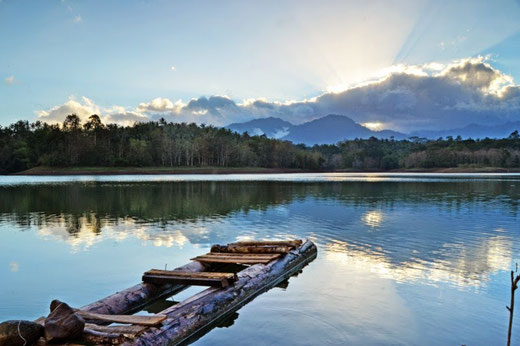
The Palasari Dam, also known as Bendungan Palasari, is a notable water reservoir. It is an important infrastructure project that serves various purposes for the region.
Location: The Palasari Dam is situated in the Palasari village, which is part of the Jembrana Regency in the western part of Bali. The dam is surrounded by scenic landscapes and provides a serene environment for visitors.
Irrigation: One of the primary functions of the Palasari Dam is to provide water for irrigation in the agricultural areas of Jembrana. The dam's reservoir helps regulate water flow, ensuring a stable water supply for rice fields and other crops, which are essential for the local economy.
Water Supply: The dam also serves as a source of water supply for domestic and industrial use in the surrounding areas. It helps meet the water needs of the local population and contributes to the region's water management.
Tourism and Recreation: Apart from its practical purposes, the Palasari Dam has become a popular spot for tourism and recreation. Its picturesque location attracts visitors who come to enjoy the scenic beauty, relax by the water, and engage in various recreational activities.

Bajra Sandhi Monument: Adjacent to the Palasari Dam, there is a historical monument known as the Bajra Sandhi Monument. This monument commemorates the struggle and spirit of the Balinese people throughout history.
Buleleng-Jembrana Canal: The water from the Palasari Dam flows through a canal known as the Buleleng-Jembrana Canal. This canal serves as an essential waterway for distributing water to various areas in Jembrana and Buleleng regencies.
The Palasari Dam is a significant infrastructure project that contributes to the development and welfare of the local communities in Jembrana. It combines practical utility with its natural beauty, making it a place of interest for both locals and tourists.
Candikusuma Beach
Large wide beach with views to Java. Very popular at weekends and holidays with the local community.
Baluk Rening Beach
This beach comes alive in August when the annual Jukung races take place. A Western facing beach with good sunset views.
Perancak & Perancak river
A small village in which Bali´s renowned Buffalo racing is performed for tourists. A reptile park and a riverside temple are other Perancak sites. The village is named after its ancient temple, Pura Ancak, where the Hindu priest Dang Hyang Nirartha first set food on Bali.
Perancak River is one of the prominent natural attractions in Jembrana Regency. The river is situated on the western coast of Bali and offers a range of touristic possibilities for travelers looking to explore the region's natural beauty and cultural heritage.
Boat Tours: One of the best ways to experience the Perancak River is by taking a boat tour. Local guides can navigate through the river's channels, providing visitors with an opportunity to immerse themselves in the mangrove forests and observe the diverse flora and fauna of the area. Birdwatching is particularly popular along the riverbanks, as the mangroves attract various bird species.
Mangrove Exploration: The Perancak River is surrounded by lush mangrove forests, which play a vital role in the coastal ecosystem. Travelers can explore these mangrove forests on guided tours, learning about their ecological significance and the efforts being made to preserve them.
Sustainable Tourism Initiatives: Several eco-tourism initiatives have been developed around the Perancak River. These initiatives focus on promoting responsible and sustainable tourism practices, helping visitors understand the importance of conservation and the impact of their visit on the environment.
Local Culture: The villages near the Perancak River offer an opportunity to experience the local Balinese culture and way of life. You can interact with the friendly villagers, witness traditional ceremonies, and learn about their customs and traditions.
Sunset Views: The area around Perancak River provides beautiful sunset views over the Bali Sea. Watching the sun dip below the horizon is a serene and magical experience.
Photography: For photography enthusiasts, Perancak River offers plenty of picturesque moments. From the serene river winding through the mangroves to the colorful boats and the local life, there are many opportunities to capture stunning shots.
Relaxation and Nature Appreciation: The tranquil setting of the Perancak River is perfect for relaxation and appreciating the beauty of nature. Travelers can take leisurely walks along the riverbanks or simply sit by the water, enjoying the peaceful ambiance.
It's worth noting that the tourism infrastructure around Perancak River may not be as developed as some other popular tourist destinations in Bali. However, this can also be an advantage for travelers seeking a more off-the-beaten-path experience and a chance to connect with nature and local communities on a more intimate level.
Delod Berawah Beach
Delod Berawah is a traditional. It is situated on the western part of the island and is known for its lush green rice fields, traditional Balinese architecture, and unique cultural experiences. The village offers tourists a glimpse into rural life in Bali and provides opportunities to learn about traditional agriculture and local customs.
Traditional Rice Fields: The village is surrounded by terraced rice fields, a common sight in Bali's countryside. The vibrant green rice paddies create a picturesque landscape and offer visitors a chance to witness the traditional rice farming methods still practiced by local farmers.

Agricultural Activities: In Delod Berawah, tourists can actively participate in various farming activities. Visitors can try their hand at planting or harvesting rice, plowing fields using traditional methods with water buffalo, and engaging in other agricultural tasks alongside the local farmers.
Cultural Experiences: The village provides a genuine cultural experience, allowing visitors to interact with the friendly local community and gain insights into their daily lives and traditions. You can witness traditional ceremonies, observe artisans creating intricate handicrafts, and learn about Balinese customs and rituals.
Balinese Architecture: Delod Berawah showcases traditional Balinese architecture with its characteristic elements, such as ornate gateways, intricately carved stone statues, and family compounds. Exploring the village's layout and structures provides an understanding of the island's architectural heritage.
Community-Based Tourism: Delod Berawah has embraced community-based tourism, where locals are actively involved in offering authentic experiences to visitors. This approach ensures that tourism benefits the local community directly and helps preserve their cultural heritage and environment.
Scenic Landscape: Apart from rice fields, the village is surrounded by natural beauty. The picturesque countryside with coconut trees, small rivers, and vibrant flora adds to the overall charm of Delod Berawah.
Eco-Tourism: The village's eco-tourism initiatives focus on sustainable practices and promoting responsible tourism. Visitors are encouraged to support environmentally friendly activities and contribute to the conservation of the region's natural resources.
Rambut Siwi
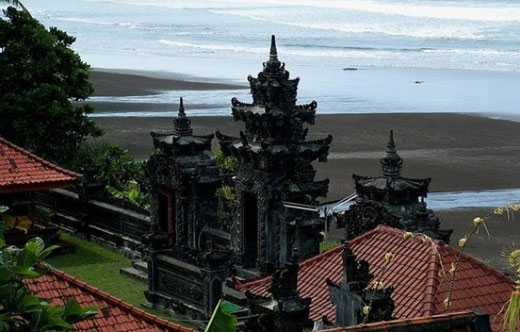
Rambut Siwi Temple, also known as Pura Rambut Siwi, is a significant Hindu temple located in the Jembrana Regency. It is one of the essential temples on the island and holds great cultural and religious importance for the local Balinese community.
The temple is situated along the western coast of Bali, close to the village of Yeh Embang. Its coastal location offers visitors stunning views of the Indian Ocean, making it not only a place of religious worship but also a picturesque destination for tourists.
The name "Rambut Siwi" translates to "holy hair" in Indonesian, and it is derived from a local legend. According to the legend, a Hindu sage named Danghyang Nirartha, who played a crucial role in shaping Bali's culture and religion, visited the temple and left some of his holy hair strands there. This event is believed to have given the temple its name and added to its sacred significance.
Rambut Siwi Temple is dedicated to Lord Shiva, one of the principal deities in Hinduism. As with many Hindu temples in Bali, Rambut Siwi features beautiful traditional Balinese architecture, with intricate carvings and colorful decorations. The temple complex is composed of several shrines and pavilions, each serving a specific religious function.
Devotees and visitors can explore the temple grounds, participate in Hindu rituals, and observe traditional ceremonies that take place regularly. The temple's serene and spiritual ambiance, combined with its coastal location, makes it a unique and culturally enriching experience for those interested in Balinese culture and Hindu traditions.
Bunut Bolong
Bunut Bolong is a famous and unique tourist attraction located in the Jembrana Regency of Bali, Indonesia. It is a majestic banyan tree (Ficus benjamina) that has grown in a way that creates a natural tunnel-like structure, with a road passing right through it. This remarkable tree and its captivating surroundings draw both local visitors and tourists alike.
The name "Bunut Bolong" translates to "tree with a hole" in the Indonesian language, which accurately describes the tree's distinctive feature. The massive branches of the banyan tree have extended and merged over time, creating an arch-shaped opening in the middle. This natural tunnel is wide enough to allow vehicles to pass through, making it a fascinating and somewhat surreal sight.
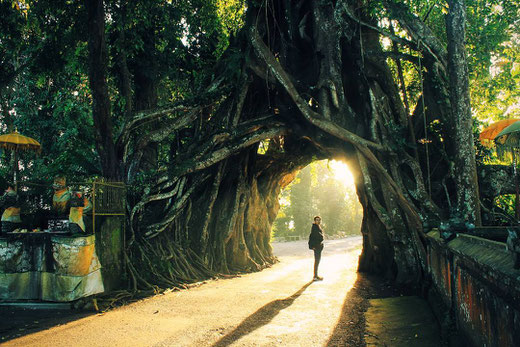
The tree has cultural and spiritual significance for the local Balinese people. In Balinese Hinduism, certain large and ancient trees, including banyan trees, are considered sacred and often believed to be dwelling places for spirits. As a result, Bunut Bolong holds religious importance, and local ceremonies and offerings may take place here to pay respects to the spirits believed to reside within the tree.
Apart from its religious significance, Bunut Bolong has become a popular tourist spot due to its unique natural beauty and the mesmerizing experience of driving through the tree's tunnel. Visitors can walk or drive through the tunnel, and there are areas around the tree where one can take photographs and enjoy the serene surroundings.
As with any natural attraction, it's important to be mindful of the environment and follow any guidelines or regulations in place to preserve this beautiful site for future generations to enjoy.
Pengambengam
The biggest fishing port on Bali, not an actual port but the sea is here at their calmest and there are no dangerous reefs.
Asah Duren
Twenty kilometers inland from Negara, the road climbs into the foothills. At Asah Duren, large clove plantations surround the village. In the past, the principal clove-growing areas in Indonesia were in Sumatra and Maluku, but in the last decade Bali has become a major producer.
Bamboo Music and Folk-Dancing
In the Northern part of West Bali, near the Jembrana border, are a large number of coffee plantations. This is where the Joged Bumbung music and dance groups are thought to have first originated. Flirtatious dance performances of similar genre are now popular throughout Bali.
One particular group from Tegal Cangkring was so popular in the 1940´s that they used to take a wooden ox-cart to performances to carry home all the coffee they were given. ¨Bumbung¨ means bamboo tube, and the instruments of the Joged consist of a number of bamboo xylophones.
Another variety of these, known as the Jegog, are specific to the Jembrana region. These are made of such large bamboo that the players have to sit on their instruments. The sounds produced by these attractive instruments is mellow and haunting, very pleasing for the ears.
comments
This list is for sure not complete. We welcome your comments and encourage you to share additional touristic, cultural, or historical facts about this regency. Your insights will benefit other readers visiting this page.

